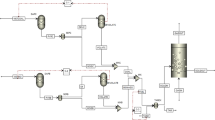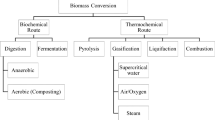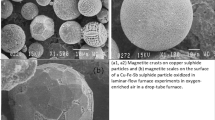Abstract
The article presents the results of experimental studies performed for the comparative analysis of factors affecting the concentration of the main gas emissions during the combustion of fuel suspensions obtained from coal enrichment waste. The factors influencing the formation of anthropogenic emissions during the flaring of coal-water fuel suspensions were investigated. Experiments were carried out with coal processing waste, both with and without additives in the form of spent mineral oil. The article shows how the concentration of sulfur dioxide, nitrogen dioxide, and hydrocarbons is affected by the parameters of preparation (particle size, solid–liquid phase ratio, additives of used engine oil) and flame combustion (temperature in the combustion chamber, excess air coefficient, and droplet size after spraying) of fuel suspensions. The ranges of parameters were selected at which the best combustion parameters are observed, based on the data obtained: degree of grinding is less than 100 μm, solid part content in the suspension is from 55 to 60%; combustion temperature is in the range from 950 to 1050° C, droplet size when spraying the suspension is less than 300 μm, additive of waste mineral oil is from 3 to 7 wt.%. and air–fuel ratio from 1.2 to 1.3.
Graphical abstract










Similar content being viewed by others
Data availability
All data generated or analyzed during this study are included in this scientific work (https://spmi.ru/sverchkov-ivan-pavlovich).
Abbreviations
- Ad :
-
Ash content on dry state, %
- Vdaf :
-
Yield of volatiles converted to a dry ash-free state, %
- Cd, Hd, Nd, Sd, Od :
-
Fraction of carbon, hydrogen, nitrogen, sulfur, and oxygen converted to a dry state, %
- Qi d :
-
Net calorific value of dry fuel at constant pressure, MJ/kg
- CWS:
-
Coal-water slurry
- CWSP:
-
Coal-water slurry containing petrochemicals
References
Akhmetshin MR, Nyashina GS, Strizhak PA (2021) Normalizing anthropogenic gas emissions from the combustion of industrial waste as part of fuel slurries. Fuel. https://doi.org/10.1016/j.fuel.2021.122653
Alexandrova Tatyana, Rasskazova Anna (2016) Studying the dependence of quality of coal fine briquettes on technological parameters of their production. J Min Inst 220:573–577. https://doi.org/10.18454/PMI.2016.4.573
Anichkov SN, Babiy VF, Kozlova SG (1985) Sampling method for the content of polyaromatic hydrocarbons in combustion products of various types of fuels. Malootkhodnaya tekhnologiya v energetike. Moscow, pp. 114–119 (in Russian)
Atal A, Levendis Y (1994) Combustion of CWF agglomerates from pulverized or micronized bituminous coal, carbon black, and diesel soot. Combust Flame 93(4):326–342. https://doi.org/10.1016/0010-2180(94)90173-2
Babiy VI, Kotler VR, Verbovetsky EKh (1996) The mechanism of formation and methods of suppression of nitrogen oxides in pulverized coal boilers. Energetik, №. 6. Moscow, pp. 8–13 (in Russian)
Bacskay G, Mackie J (2005) Oxidation of CO by SO2: a theoretical study. J Phys Chem 109(9):2019–2025. https://doi.org/10.1021/jp045086n
Bazhin V (2016) Changes in thermal plasticity of low grade coals during selective extraction of metals. J Min Inst 220:578–581. https://doi.org/10.18454/pmi.2016.4.578
Borowski G, Ozga M (2020) Comparison of the processing conditions and the properties of granules made from fly ash of lignite and coal. Waste Manag 104:192–197. https://doi.org/10.1016/j.wasman.2020.01.024
Borowski G, Smirnov Y, Ivanov A, Danilov A (2020) Effectiveness of carboxymethyl cellulose solutions for dust suppression in the mining industry. Int J Coal Prep Utilization. https://doi.org/10.1080/19392699.2020.1841177
Cheremisina O, El-Salim S (2017) Modern methods of analytical control of industrial gases. J Min Inst 228:726–730. https://doi.org/10.25515/PMI.2017.6.726
Daood S, Ord G, Wilkinson T, Nimmo W (2014) Fuel additive technology – NOx reduction, combustion efficiency and fly ash improvement for coal fired power stations. Fuel 134:293–306. https://doi.org/10.1016/j.fuel.2014.04.032
Das D (2020) Combined effect of natural dispersant and a stabilizer in formulation of high concentration coal water slurry: Experimental and rheological modeling. J Mol Liq 320:114441. https://doi.org/10.1016/j.molliq.2020.114441
Dmitrienko MA, Nyashina GS, Strizhak PA (2018) Major gas emissions from combustion of slurry fuels based on coal, coal waste, and coal derivatives. J Clean Prod 177:284–301
Efstathiou A, Olympiou G (2017) Industrial NOx control via H2 -SCR on a novel supported-ptnanocatalyst. Chem Eng J 170:424–432
Feng T, Huo M, Zhao X, Wang T, Xia X, Ma Ch (2017) Reduction of SO2 to elemental sulfur with H2 and mixed H2 / CO gas in an activated carbon bed. Chem Eng Res Des 121:191–199. https://doi.org/10.1016/j.cherd.2017.03.014
Gaber C, Wachter P, Demuth M, Hochenauer C (2020) Experimental investigation and demonstration of pilot-scale combustion of oil-water emulsions and coal-water slurry with pronounced water contents at elevated temperatures with the use of pure oxygen. Fuel 282:118692. https://doi.org/10.1016/j.fuel.2020.118692
Glushkov D, Lyrshchikov S, Shevyrev S, Strizhak P (2016) Burning Properties of Slurry Based on Coal and Oil Processing Waste. Energy & Fuels 30(4):3441–3450. https://doi.org/10.1021/acs.energyfuels.5b02881
Hu Y, Naito S, Kobayashi N, Hasatani M (2000) (2000) CO2, NOx and SO2 emissions from the combustion of coal with high oxygen concentration gases. Fuel 79(15):1925–1932. https://doi.org/10.1016/S0016-2361(00)00047-8
Lee B-H, Eddings E, Jeon C-H (2016) Effect of coal blending methods with different excess oxygen on unburned carbon and NOx emissions in an entrained flow reactor. Energy Fuels 26:6803–6814. https://doi.org/10.1021/ef300562t
Li J, Zhang X, Yang W, Blasiak W (2013) Effects of Flue Gas Internal Recirculation on NOx and SOx Emissions in a Co-Firing Boiler. Int J Clean Coal Energy 2(2):13–21. https://doi.org/10.4236/ijcce.2013.22002
Matveeva V, Isakov A, Sverchkov I (2019) The reduction of negative impact on environment in the area of coal processing enterprises // Innovation-Based Development of the Mineral Resources Sector: Challenges and Prospects - 11th conference of the Russian-German Raw Materials. pp. 431–436
Nyashina GS, Vershinina KY, Dmitrienko MA, Strizhak PA (2018) Environmental benefits and drawbacks of composite fuels based on industrial wastes and different ranks of coal. J Hazard Mater 347:359–370. https://doi.org/10.1016/j.jhazmat.2018.01.014
Poskart M, Lech S (2007) Ecological effect of air/fuel staging and flue gas recirculation on NOx formation – experimental and numerical analysis. J Min Inst 170(2):250–253
Routray A, Das D, Parhi PK, Padhy MK (2018) Characterization, stabilization, and study of mechanism of coal-water slurry using Sapindous Mukorossi as an additive. Energy Sources 40(20):2502–2509. https://doi.org/10.1080/15567036.2018.1503755
Samoilik V, Elishevich A, Makarov A (1990) Influence of the composition of mineral impurities on the rheological properties of coal-water suspensions // Khimiya tverdogo topliva №5. Moscow. pp. 76–81 (in Russian)
Shabarov A, Nikolaeva N (2016) Complex utilization of treatment wastes from thermal power plants. J Min Inst 220:607–610. https://doi.org/10.18454/PMI.2016.4.573
Silyutin S, Epshtein S (2020) Wastes from coal mining and processing. Methodological approaches to the assessment of their ecological safety and directions for use. Part 1. Characterization of solid wastes from coal mining and processing in foreign countries. MIAB 4:5–19. https://doi.org/10.25018/0236-1493-2020-4-0-5-19
Yan P, Zhang X, HeroldF, Li F, Dai X, Cao T, Etzoldc B, Qi W (2020) Methanol oxidative dehydrogenation and dehydration on carbon nanotubes: active sites and basic reaction kinetics. Catal Sci Technol 10(15):4952–4959. https://doi.org/10.1039/D0CY00619J
Zeldovich Ya B, Sadovnikov PYa, Frank-Kamenetskii DA (1947) Oxidation of nitrogen during combustion: Akademii nauk SSSR Moscow. p. 147 (in Russian)
Author information
Authors and Affiliations
Contributions
All authors contributed to the study conception and design. Material preparation, data collection, and analysis were performed by Ivan Sverchkov, Mariia Chukaeva, and Vera Matveeva. The first draft of the manuscript was written by Ivan Sverchkov, and all authors commented on previous versions of the manuscript. All authors read and approved the final manuscript.
- Conceptualization: IS formulated the idea of the research, and VM formulated the goals and aims.
- Methodology: IS designed an experimental stand for flaring liquid fuels and set up an experiment, and MC designed a method for sampling and analyzing samples.
- Formal analysis and investigation: IS and MC used statistical and mathematical methods to analyze the data obtained.
- Writing—original draft preparation: IS wrote the initial draft.
- Writing—review and editing: IS and MC prepared, created, and presented the published work, and VM prepared a critical review of scientific work.
- Supervision: VM carried out supervision and responsibility for the planning and execution of research activities.
Corresponding author
Ethics declarations
Ethics approval and consent to participate
Not applicable.
Consent to publish
Not applicable.
Competing Interests
All authors certify that they have no affiliations with or involvement in any organization or entity with any financial interest or non-financial interest in the subject matter or materials discussed in this manuscript.
Additional information
Responsible Editor: Philippe Garrigues
Publisher's note
Springer Nature remains neutral with regard to jurisdictional claims in published maps and institutional affiliations.
Highlights
− Hydrocarbons, SO2, and NO2 concentrations can be reduced by 40, 70, and 25%, respectively.
− The smallest hazard of pollutants is observed at flame temperature in the range 950–1050 °C.
− Adding from 3 to 7 wt.% of waste oil in fuel suspensions allows to obtain better energy characteristics without a significant increase of the pollutants concentrations.
Rights and permissions
About this article
Cite this article
Sverchkov, I., Chukaeva, M. & Matveeva, V. Influence of preparation and combustion parameters of coal-water slurries on gas emission chemistry. Environ Sci Pollut Res 29, 44042–44053 (2022). https://doi.org/10.1007/s11356-022-19038-9
Received:
Accepted:
Published:
Issue Date:
DOI: https://doi.org/10.1007/s11356-022-19038-9




